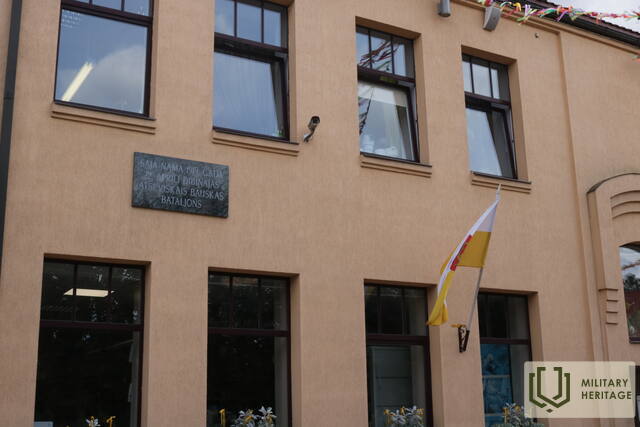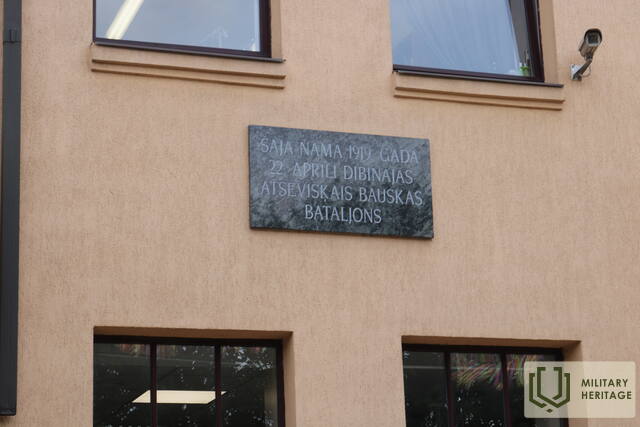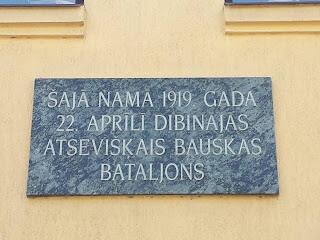Memorial plaque at the house where the Separate Bauska Battalion was founded
Memorial site

The memorial plaque at the house where the Separate Bauska Battalion was founded is a plaque made of black Swedish granite, which was unveiled on April 22, 1935, at the then Farmers' Credit Union House. The memorial plaque was installed by the Bauska municipality together with the city's public organizations. During the first year of the communist occupation, the Cheka and militia were housed in the house. In April 1941, on the orders of the Bauska militia and Cheka chief, the apprentice of locksmith Waldorf began to destroy the plaque, but, wanting to save it, he knocked off only the lower right corner, but then announced that it was impossible to break it. He recommended that the plaque be painted with white lime paint, which was done. After the Bolsheviks were driven out, the paint was washed off, but when they returned, the plaque was painted over again. During the revival, it was cleaned again. The building itself was partially destroyed in 1944 during the war. Today, the building has been renovated while preserving its historical dimensions. The building houses commercial establishments, and nothing has survived from the historical interior. The building can only be viewed from the outside.
The separate Bauska battalion was formed in Bauska on April 24, 1919. The commander of the German forces stationed in Bauska did not object to the mobilization of the Latvians and the formation of the battalion, based on the general mobilization announced by the Latvian government from April 22 to 24. Approximately 300 citizens responded to the mobilization, and three companies were formed. Latvian officers were appointed company commanders, but the command of the battalion was initially entrusted to the German lieutenant Bettiher, who was only replaced at the end of May by a Latvian officer, Captain V. Kevei-Gudže. The commander of the German troops stationed in Courland, Rüdiger von der Golz, forbade the battalion to be subordinated to the Latvian Separate Brigade commanded by Colonel Jānis Baložs, and it was attached to the formations of the German 1st Guards Reserve Division, including Brandis's division, which was defending Bauska at that time. On April 28, the Bolsheviks began an attack on Bauska. At that time, the battalion was armed with only a 50-man squad that was involved in the battle. This unit managed to drive the Bolsheviks out of Derpeļmuiža, preventing a critical situation and stopping the enemy's attack. Immediately after the battle, the entire battalion was armed, but the Germans still did not provide it with automatic weapons. The battalion obtained its first machine guns as trophies in a battle with the Bolsheviks on May 1 and 2. New trophies, as well as 27 prisoners, were received by the battalion's reconnaissance group on May 11 in the village of Pērkoniškis in Lithuanian territory.
On May 18, when a new large-scale Bolshevik attack on Bauska began, the battalion was in positions on the banks of the Mūsa River opposite the Ceraukste Manor, where it repelled all enemy attacks. After the Bolsheviks were driven out of Riga on May 22, the battalion's combat operations in this sector of the front also ended. The battalion arrived at the Latgale Front on August 5, where it took up positions on the Rubene-Izabelina line, but already on August 16, 1919, it was included in the newly formed 3rd Jelgava Infantry Regiment as the 2nd Battalion.
Used sources and references:
https://karavirukapi.blogspot.com/2019/04/bauska-pieminas-plaksne-pie-nama-kur.html
https://arhivs.bauskasdzive.lv/raksts/182051














